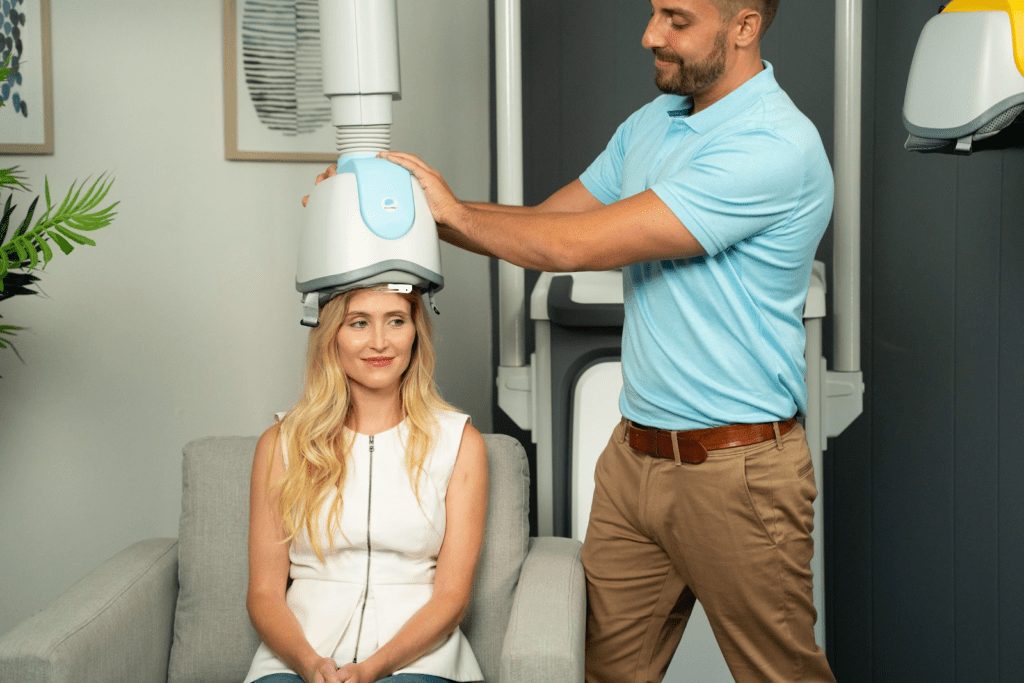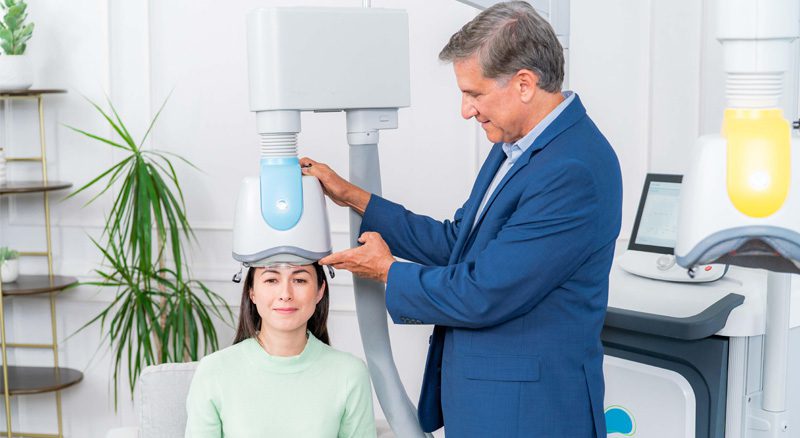
Imagine a gentle approach, without medication or surgery, to help relieve the symptoms of major depression—that’s what Transcranial Magnetic Stimulation (TMS) offers. Using magnetic fields, this non-invasive technique gently stimulates areas of the brain involved in mood regulation. TMS represents a new avenue of hope for those who haven’t found relief with traditional treatments. Learn what you need to know about this technique that works directly on the brain’s electrical activity to improve depressive states.
What is TMS?
Like Neurofeedback, TMS is among the innovative techniques available today to support individuals affected by major depression, a condition with a yearly prevalence of 7.6% among the Canadian population.
TMS and Neurofeedback share a noninvasive approach. Transcranial Magnetic Stimulation uses magnetic fields to gently stimulate nerve cell activity in brain regions responsible for mood regulation. This technique can be seen as a targeted magnetic boost to areas of the brain that need reactivation to improve emotional well-being. Unlike medications, which affect the entire body and may cause side effects, TMS targets specific brain areas. It is often considered when drug treatments fail to provide the expected relief.
Comparing TMS and Neurofeedback
Neurofeedback is a different technique from TMS. While it also aims to improve brain function, including in cases of depression, it operates distinctly.
Differences Between TMS and Neurofeedback
Although both TMS and Neurofeedback are non-invasive approaches targeting the brain to improve conditions like depression, they are fundamentally different techniques.
- TMS uses external magnetic pulses to stimulate neuronal activity in specific brain areas directly. This intervention is considered more direct and is administered by trained professionals.
- On the other hand, neurofeedback is an active learning process that enables individuals to modify their brain activity using real-time feedback and a reward system. No direct stimulation is applied to the brain during a Neurofeedback session.
A few specific characteristics help distinguish each method:
- TMS delivers external stimulation,
- Neurofeedback enables the brain to self-regulate through learning,
- TMS is often a shorter and more intensive treatment,
- Neurofeedback may require more regular sessions, similar to a training program.
When is TMS Appropriate?
Transcranial Magnetic Stimulation (TMS) is considered a treatment option when certain mental health or neurological conditions are present. It is primarily suitable for improving symptoms in cases of major depression, particularly for individuals who have not experienced sufficient relief from antidepressant medications.
The so-called Deep TMS method is even approved for treating depression in individuals aged 68 to 86. TMS, and especially Deep TMS, can also be an alternative for those suffering from anxious depression.
A Multi-Purpose Approach
Beyond depression, TMS also shows promise for other disorders. Physicians may use this method to improve symptoms of obsessive-compulsive disorder (OCD) or to assist with smoking cessation. Ongoing research in recent years has been evaluating the potential of TMS in improving other conditions, such as Alzheimer’s disease and certain addictions.
A Technique with Several Contraindications
There are several contraindications to using TMS:
- This technique is generally contraindicated in individuals with metallic or electronic implants in the head, such as cochlear implants or metal plates in the skull.
- The presence of pacemakers or implanted pumps, particularly those with detection features, such as defibrillators, may also be a contraindication.
- Individuals with a personal history of epilepsy or head trauma with loss of consciousness are typically excluded from TMS treatment.
What Are the Benefits of TMS?
TMS offers numerous advantages, particularly for people dealing with major depression:
- A non-invasive technique: Unlike other methods, TMS does not require surgery or the implantation of electrodes. The sessions only involve placing a device with a magnetic coil on the scalp. There’s no anesthesia involved, and individuals can resume their normal activities immediately after each session.
- A medication-free alternative: Another key advantage of TMS is that it generally does not involve medication use. For those who prefer to avoid drugs or have experienced undesirable side effects from antidepressants, TMS presents an appealing alternative. The technique does not cause side effects like fatigue or insomnia, or impair alertness or memory.
- Proven effectiveness for many individuals, especially those who haven’t seen positive results from traditional drug treatments. TMS can provide significant relief from depressive symptoms, with many people reporting improved mood and a return to better quality of life after completing therapy.
6 Frequently Asked Questions About TMS
Transcranial Magnetic Stimulation (TMS) requires a medical device consisting mainly of a magnetic coil placed outside the head. This coil is connected to a machine that sends electrical pulses through it. These pulses generate a targeted magnetic field that passes through the skull to reach specific brain areas.
Some TMS systems, such as BrainsWay’s Deep TMS, use specially designed coils that stimulate broader and deeper brain regions. These advanced technologies help accurately target neural networks.
The duration of TMS treatment varies depending on the specific protocol established by the healthcare provider. A full course of therapy for major depression can last between 1 and 9 weeks. During this period, sessions are held multiple times per week—some protocols, for instance, require five sessions per week.
Each TMS session is generally short, lasting about 20 minutes or less on average. However, the time spent at the clinic may be slightly longer due to preparation and equipment setup.
The effectiveness of TMS is clinically proven. Health Canada has recognized and approved this technique for improving depression symptoms since 2002, and the U.S. FDA also approves it for the treatment of major depressive disorder.
During a TMS session, the person sits comfortably in a chair. The healthcare professional carefully places the magnetic coil on the scalp, over the targeted area of the brain.
During the session, the coil emits magnetic pulses, and the device makes a clicking or tapping sound. To protect your hearing, earplugs are mandatory and will be provided before the session begins.

Check with the provincial and private health insurance plans to determine TMS reimbursement policies. Some insurance providers offer coverage, particularly if other treatments have not been effective and if a specialized psychiatrist prescribes TMS.
TMS is generally considered a safe and well-tolerated technique, with mild and temporary side effects. The most common ones can occur during or immediately after a session, such as mild to moderate headaches, pain or discomfort at the scalp where stimulation occurs, and a tapping sensation.


